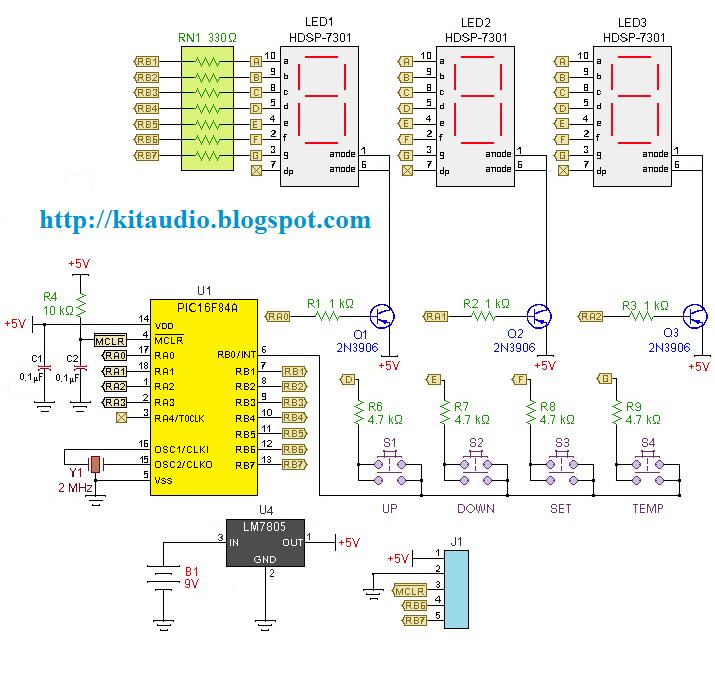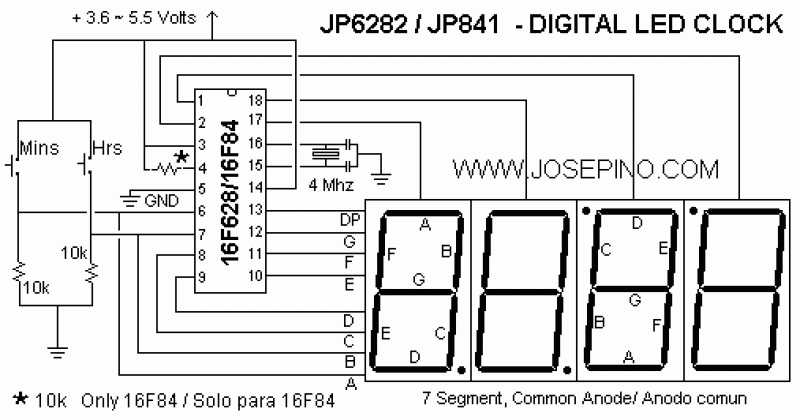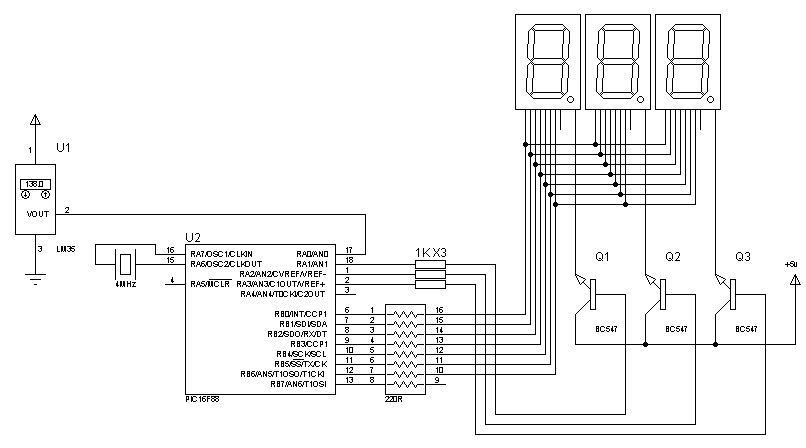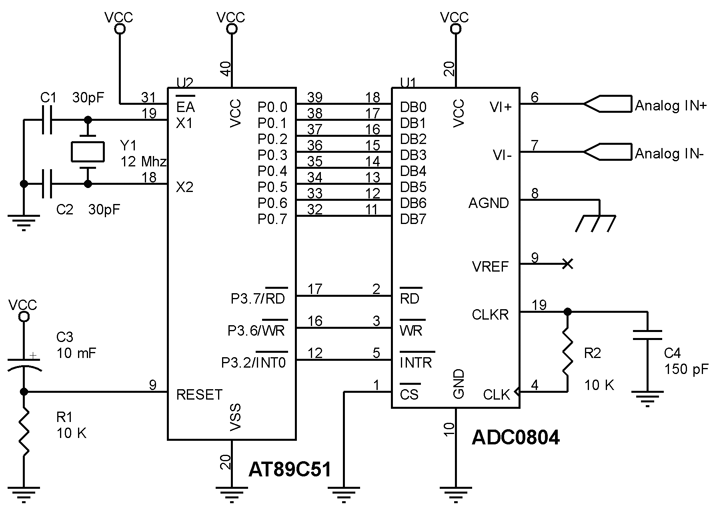
digital thermometer with pic16f84

Redesign a complex solution using minimal external components, resulting in a low-cost application that provides high-precision measurements. This digital thermometer microcontroller project utilizes a watchdog timer function to measure temperature. The watchdog timer (WDT) on all PIC microcontrollers has a nominal timeout period of 18 ms. The WDT timeout period varies with temperature, VDD, and part-to-part process variations. The system consumes very little operating current; however, if any key is pressed, it wakes up from sleep mode, updates the WDT count, and checks for additional key presses. If no key presses are detected, it returns to sleep mode. To calibrate the system, place it in the temperature forcing system at the higher of the two calibration temperatures and wait 5 minutes for the temperature to stabilize. Press the SET key to store the new low-temperature calibration in data EEPROM, and the firmware sets a flag (Default) to indicate that new calibration information is available.
This digital thermometer project leverages a microcontroller with integrated WDT functionality to maintain precise temperature measurements while minimizing power consumption. The design emphasizes the importance of using a minimal number of external components, which not only reduces the overall cost of the application but also simplifies the assembly and maintenance processes.
The WDT plays a crucial role in ensuring the device operates reliably. With a nominal timeout period of 18 ms, it serves as a fail-safe mechanism that resets the microcontroller in case of software malfunctions or unexpected conditions. The variability of the WDT timeout period due to changes in temperature, supply voltage (VDD), and manufacturing process variations must be accounted for in the design to ensure consistent performance across different operating conditions.
The low power consumption of the system is a significant advantage, allowing it to operate efficiently in battery-powered applications. The microcontroller enters a low-power sleep mode when inactive, significantly extending battery life. The ability to wake from sleep mode upon key press enhances user interaction while maintaining energy efficiency. The WDT count is updated with each key press, ensuring that the system remains responsive without compromising power efficiency.
Calibration is a critical aspect of maintaining measurement accuracy. By placing the device in a controlled temperature environment and allowing sufficient time for stabilization, reliable calibration data can be obtained. The SET key facilitates the calibration process, enabling users to store new temperature settings in the EEPROM. The firmware’s implementation of a flag to indicate updated calibration information ensures that the system can easily manage and utilize the latest calibration data without manual intervention.
Overall, this digital thermometer microcontroller project exemplifies a well-thought-out design that balances cost, precision, and user-friendly features, making it suitable for a variety of applications requiring accurate temperature measurement.Resign a complex solution using few external components, resulting an low cost application that provide a high precision measurement. This Digital thermometer microcontroller project use watchdog timer function to measure temperature. The WDT on all PIC-micro microcontrollers has a nominal time-out period of 18 ms. The WDT time-out period varies with temperature, VDD and part-to-part process variations. very little operating current but if any key is pressed, it wakes up` from SLEEP and updates the WDT count, and checks for additional key presses. If there are none, it returns to SLEEP mode. 1. Place the system in the temperature forcing system at the higher of the two calibration temperatures, and wait 5 minutes for the temperature to stabilize.
7. Press the SET key. The new low temperature calibration is stored in data EEPROM, and the firmware sets a flag (Default) to indicate that new calibration information is available. 🔗 External reference
This digital thermometer project leverages a microcontroller with integrated WDT functionality to maintain precise temperature measurements while minimizing power consumption. The design emphasizes the importance of using a minimal number of external components, which not only reduces the overall cost of the application but also simplifies the assembly and maintenance processes.
The WDT plays a crucial role in ensuring the device operates reliably. With a nominal timeout period of 18 ms, it serves as a fail-safe mechanism that resets the microcontroller in case of software malfunctions or unexpected conditions. The variability of the WDT timeout period due to changes in temperature, supply voltage (VDD), and manufacturing process variations must be accounted for in the design to ensure consistent performance across different operating conditions.
The low power consumption of the system is a significant advantage, allowing it to operate efficiently in battery-powered applications. The microcontroller enters a low-power sleep mode when inactive, significantly extending battery life. The ability to wake from sleep mode upon key press enhances user interaction while maintaining energy efficiency. The WDT count is updated with each key press, ensuring that the system remains responsive without compromising power efficiency.
Calibration is a critical aspect of maintaining measurement accuracy. By placing the device in a controlled temperature environment and allowing sufficient time for stabilization, reliable calibration data can be obtained. The SET key facilitates the calibration process, enabling users to store new temperature settings in the EEPROM. The firmware’s implementation of a flag to indicate updated calibration information ensures that the system can easily manage and utilize the latest calibration data without manual intervention.
Overall, this digital thermometer microcontroller project exemplifies a well-thought-out design that balances cost, precision, and user-friendly features, making it suitable for a variety of applications requiring accurate temperature measurement.Resign a complex solution using few external components, resulting an low cost application that provide a high precision measurement. This Digital thermometer microcontroller project use watchdog timer function to measure temperature. The WDT on all PIC-micro microcontrollers has a nominal time-out period of 18 ms. The WDT time-out period varies with temperature, VDD and part-to-part process variations. very little operating current but if any key is pressed, it wakes up` from SLEEP and updates the WDT count, and checks for additional key presses. If there are none, it returns to SLEEP mode. 1. Place the system in the temperature forcing system at the higher of the two calibration temperatures, and wait 5 minutes for the temperature to stabilize.
7. Press the SET key. The new low temperature calibration is stored in data EEPROM, and the firmware sets a flag (Default) to indicate that new calibration information is available. 🔗 External reference





